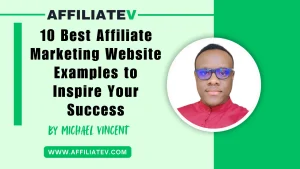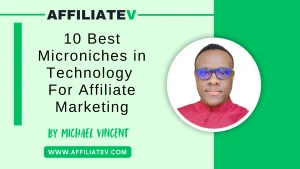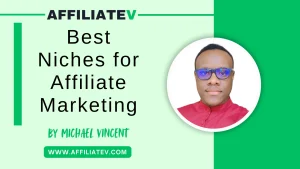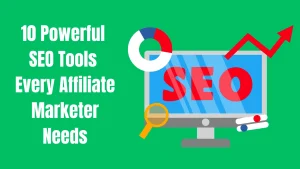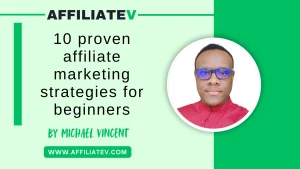How to Create High-Converting LinkedIn Posts for Affiliate Marketing (7 Simple Ways)
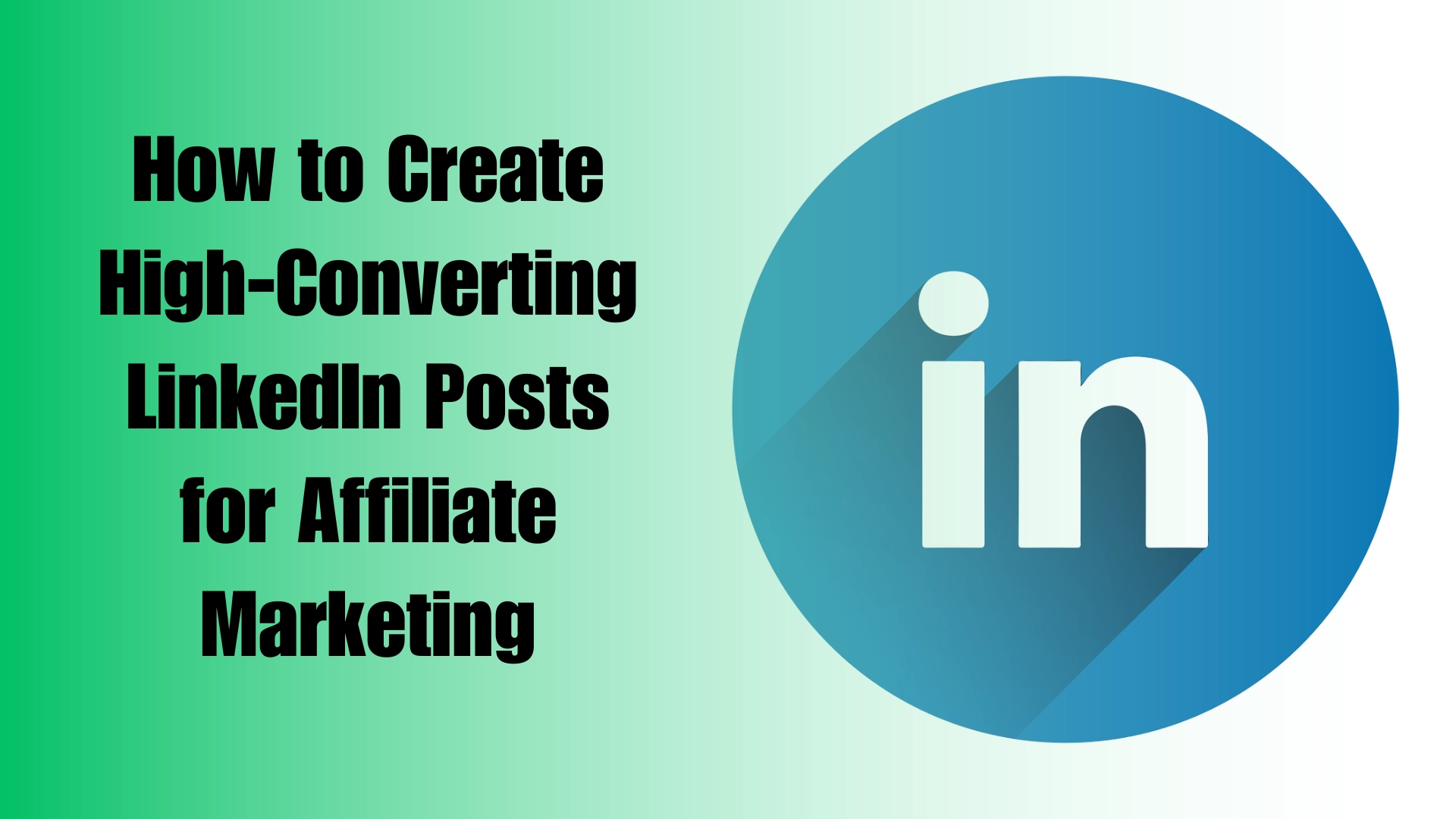
LinkedIn is one of the most underrated platforms for affiliate marketing. Many think of it as a space for networking or job searching, but it’s much more than that.
It’s a platform where professionals actively look for tools, insights, and solutions to improve their businesses and careers. If you position yourself well, you can connect with an audience that is ready to invest in quality products and services.
But posting randomly won’t work. To succeed, you need high-converting posts—content that grabs attention, delivers value, and encourages action.
Unlike other social platforms, LinkedIn users expect useful and professional content, not aggressive sales pitches. If your posts feel too promotional, they’ll get ignored. If they don’t provide enough value, people won’t engage.
This guide will walk you through how to create LinkedIn posts for affiliate marketing that actually work. You’ll learn how to:
- Understand your audience and what type of content they respond to
- Choose the right post format to maximize engagement
- Write compelling hooks that make people stop scrolling
- Provide value first before promoting anything
- Use affiliate links the right way without sounding pushy
- Boost visibility and engagement using LinkedIn’s algorithm
- Track performance and refine your strategy over time
By the end, you’ll have a clear strategy to turn LinkedIn into a source of affiliate commissions—without relying on luck. Let’s get started.
How to Create LinkedIn Posts for Affiliate Marketing that Actually Work
1. Know Your LinkedIn Audience Before You Post
Affiliate marketing on LinkedIn works best when you know exactly who you’re speaking to. Many people make the mistake of posting random content, hoping it will reach the right audience.
That rarely works. To get engagement and conversions, you need to understand who your audience is, what they care about, and how to make your content relevant to them.
a). Why Knowing Your Audience Matters
LinkedIn is filled with professionals, business owners, and decision-makers. They aren’t scrolling for fun—they’re looking for insights, strategies, and tools to help them succeed.
If your content speaks directly to their needs, they’ll engage with it. Before posting, take a step back and think about the people who would benefit most from the products or services you’re promoting.
Are they freelancers trying to grow their income? Are they small business owners looking for better tools? Do they struggle with time management, marketing, or productivity? The more specific you get, the better your content will perform.
b). How to Identify Your Audience on LinkedIn
Understanding your audience isn’t guesswork. LinkedIn provides valuable insights to help you see who is engaging with your content. Start by looking at your existing connections and followers. Check their job titles, industries, and the type of content they interact with.
If you notice a pattern—like a majority being small business owners—you should focus on content that provides solutions for them.
Comments and direct messages can also tell you a lot. Pay attention to the questions people ask and the topics they respond to the most. If you see the same concerns or struggles coming up repeatedly, that’s a clear sign of what your future posts should focus on.
c). Use LinkedIn’s Engagement Tools for Research
Another way to gather insights is by using LinkedIn’s engagement tools. Posting a poll or asking a direct question can give you real feedback from your audience. For example, if you promote digital marketing tools, you could ask:
“What’s your biggest challenge with online marketing?”
The responses will tell you exactly what your audience needs help with, allowing you to create content that feels relevant to them.
d). Create Posts That Speak to Your Audience’s Needs
When your posts directly address your audience’s struggles and interests, they will naturally perform better. People engage with content that feels like it was written for them.
And when they trust your insights, they’re far more likely to take action on your recommendations, including clicking on your affiliate links.
If you want to dive deeper into building the right connections and engaging the right people, check out The LinkedIn® Book for Sales and Marketing—it’s packed with insights on how to attract and connect with the right audience.
2. Choose the Right Content Format for Maximum Engagement
Posting on LinkedIn is mainly about how you present your ideas. Different post formats work better for different messages, and choosing the right one can increase visibility, engagement, and conversions. Here’s how to use each type effectively in affiliate marketing.
a). Text-Only Posts: When Simplicity Wins
Sometimes, words alone are enough to grab attention. Text-only posts work best for personal insights, storytelling, and thought-provoking questions. Since LinkedIn prioritizes conversations, a well-crafted post can spark engagement without any visuals.
Here is an example of a text-only post:
How to use it for affiliate marketing:
- Share a personal experience about a tool or strategy that improved your results.
- Pose a question to your audience, like: “What’s the biggest challenge you face with [problem your affiliate product solves]?”
- Share a step-by-step tip and end with a call-to-action (CTA) to check out a resource.
The key is to make the content feel like a natural conversation. If it reads like an ad, people will scroll past it.
b). Image-Based Posts: Visuals That Stop the Scroll
A strong image makes people pause. High-quality visuals can help simplify complex ideas, emphasize key points, or add personality to your content. But not all images work—random stock photos won’t do much.
Best practices:
- Use original images, branded graphics, or screenshots of results to build trust.
- Overlay short, bold text on the image to highlight the key message.
- Avoid clutter—keep it clean and easy to read.
Affiliate marketing examples:
- Post a screenshot of earnings growth after using a product, with a caption explaining how it helped.
- Share an infographic breaking down a strategy step by step.
- Use before-and-after visuals to show the impact of a tool or service.
c). Video Posts: Engaging and Personal
People connect with faces and voices. Videos help build trust because they feel more personal and real. They’re great for explaining concepts, demonstrating products, or sharing quick insights.
Why they work:
- Videos keep people on your post longer, signaling LinkedIn to boost its reach.
- They make complex topics easier to understand.
- They feel more authentic, making them great for recommendations.
How to use them for affiliate marketing:
- Record a short clip explaining why you love a product and how it helped you.
- Walk through a tool’s features with a screen-recording tutorial.
- Share a behind-the-scenes look at how you use an affiliate product in your daily work.
Short videos (30-90 seconds) usually perform best. Keep it conversational, and avoid sounding like a sales pitch.
d). Document (Carousel) Posts: Storytelling That Keeps People Swiping
Carousels (multi-page PDFs) are one of LinkedIn’s best formats for engagement. They encourage interaction because users have to swipe through them, signaling LinkedIn to show them to more people. They’re great for storytelling, breaking down concepts, or sharing lists.
Best ways to use them:
- Create a step-by-step guide on solving a common problem.
- Share case studies with real results.
- Compare different tools and recommend the best one.
Affiliate marketing example:
- A carousel titled “5 Tools That Save Me Hours Each Week” with each slide explaining one tool and ending with a CTA.
- A case study showing how a specific product increased conversions, ending with a link to try it.
The Right Format Makes is Important
When you choose the right content format, you set the stage for better engagement. From text posts to videos, each type offers its own benefits.
If you’re looking for more creative ways to present your posts, take a look at 101 Ideas for LinkedIn® – Content Made Easy. This guide is full of fresh ideas that can help you decide which format best fits your message and audience.
3. Craft a Compelling Hook That Stops the Scroll
The first few lines of your post determine whether people keep reading or scroll past. LinkedIn only shows the first two to three lines before cutting off the rest with a “See more” button. If those lines don’t grab attention, your post won’t get the engagement it deserves.
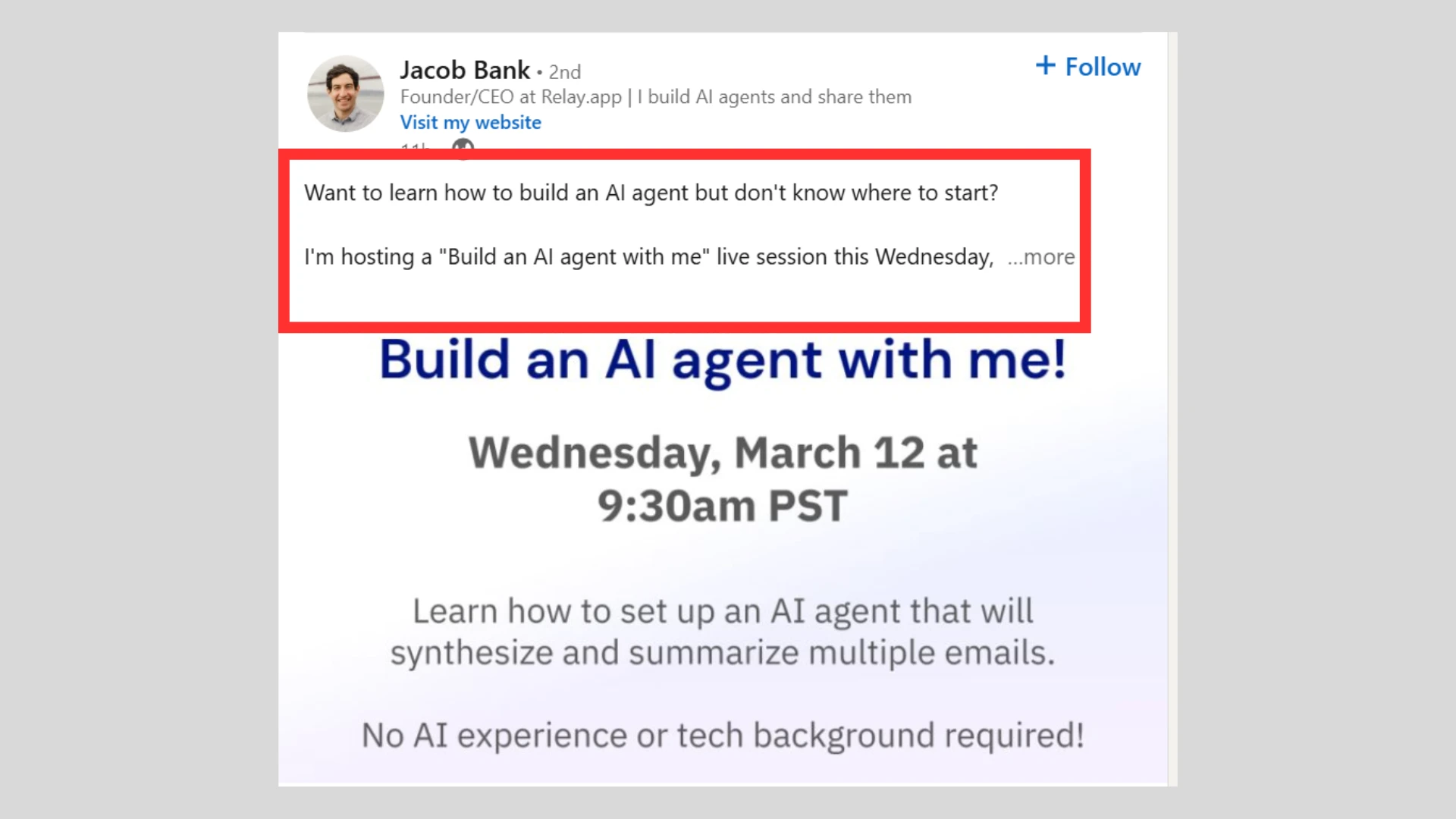
A strong hook stirs curiosity, creates an emotional connection, or highlights a problem that needs solving. It makes people think, “I need to read this.”
Why Your First Few Lines Matter
People scroll through LinkedIn quickly. You have about two seconds to grab their attention. If your opening lines are dull, vague, or too long, they’ll keep scrolling. A compelling hook makes them stop, read more, and engage with your post.
Here’s an example of a weak opening:
“Affiliate marketing is a great way to make money online. Here’s what you need to know.”
That’s boring. It tells people nothing new and gives them no reason to keep reading. Now, compare it to this:
“I wasted six months on affiliate marketing with ZERO results. Here’s what I did wrong—and how I fixed it.”
That works because it creates curiosity and hints at a valuable lesson.
Examples of Powerful Hooks
A good hook grabs attention immediately. Here are a few formats that work well:
1. Start with a Bold Statement
People love strong opinions and surprising facts.
- “Most affiliate marketers fail—not because they’re lazy, but because they make this ONE mistake.”
- “If you’re adding affiliate links to every post, you’re doing it wrong.”
These statements challenge common beliefs and make readers want to know more.
2. Ask a Thought-Provoking Question
Questions make people stop and think, increasing the chances of engagement.
- “Why do some affiliate marketers make six figures while others struggle for a single sale?”
- “Would you still promote a product if you couldn’t earn a commission on it?”
A good question makes people curious about your answer.
3. Highlight a Pain Point
If your audience struggles with a specific problem, call it out immediately.
- “You’re posting on LinkedIn daily, but no one engages. Here’s why.”
- “Affiliate marketing isn’t working for you? You might be making these mistakes.”
Pain points get attention because they feel personal. When people relate to your opening, they’ll keep reading.
4. Tell a Short, Intriguing Story
Stories draw people in. Keep it short—just enough to make them curious.
- “Three years ago, I signed up for my first affiliate program. I thought I’d make easy money. I was wrong.”
- “I once made $1,200 from a single LinkedIn post. Here’s exactly how I did it.”
A good story teases just enough to make people want the full details.
5. Use a Problem-Solution Approach
Start with a challenge, then hint at the solution.
- “Struggling to get clicks on your affiliate links? Here’s what actually works.”
- “Affiliate commissions dropping? Try this instead.”
This works because people want solutions to their problems.
Turn Hooks Into Habit
A great hook makes the difference between a post that gets ignored and one that goes viral. The more you test different opening lines, the better you’ll get at grabbing attention.
Before publishing a post, ask yourself:
- Would this make me stop scrolling?
- Does it spark curiosity or emotion?
- Does it make people want to read more?
If not, rewrite it. Your first two lines are your best chance to pull people in—use them wisely.
Writing a strong hook on LinkedIn makes all the difference. Personally, I use EasyGen to quickly generate ideas and craft openings that grab attention. It helps me write posts that actually get people to stop scrolling and engage. If you ever struggle with how to start a post, this tool is worth trying.
4. Give Value First—Earn Trust Before Promoting
Affiliate marketing isn’t just about dropping links and hoping for sales. People buy from those they trust. If your content feels like a sales pitch, they’ll ignore it. But if you provide real value first, they’ll listen when you recommend something.
Why Trust Comes Before Sales
Think about your own experience. Would you buy a product just because someone posted a link? Probably not. You’d want to know:
- Why should I care?
- Has this worked for others?
- Is this person just trying to sell me something?
Your audience thinks the same way. If they don’t trust you, they won’t buy from you. That’s why value comes first, promotion comes later.
How to Provide Value
There are three main ways to give value before promoting anything: Educate, Entertain, or Inspire.
1. Educate: Teach Something Useful
People love learning things that help them solve problems or improve their skills. If your content makes their life easier, they’ll keep coming back.
Examples:
- Break down a complex topic → “Here’s the easiest way to choose an affiliate program that actually pays.”
- Share a step-by-step guide → “Follow these 3 steps to increase your affiliate commissions without extra work.”
- Compare products honestly → “I tested two affiliate programs side by side—here’s which one made me more money.”
When you teach something valuable, people see you as a go-to resource. And when they’re ready to buy, they’ll trust your recommendations.
2. Entertain: Make It Engaging
People scroll LinkedIn for insight, but also for content that’s enjoyable to read. If your posts feel robotic or forced, they’ll lose interest fast.
Examples:
- Tell a relatable story → “I once made $0 for months because I ignored this simple affiliate marketing rule.”
- Use humor → “Affiliate marketing is great—until you realize signing up for a program doesn’t equal getting paid.”
- Make bold, unexpected statements → “Your affiliate links aren’t converting because you’re doing THIS wrong.”
Engaging content keeps people hooked. When they enjoy reading your posts, they’ll remember you—and that builds trust.
3. Inspire: Share Success and Lessons Learned
People love success stories, but they also respect honesty about failures. If you show real experiences, they’ll relate to you.
Examples:
- Personal struggles → “I made every affiliate marketing mistake possible. Here’s what finally worked.”
- Customer wins → “A beginner followed my advice and made their first $500 in commissions—without paid ads.”
- Before-and-after transformations → “I used to waste time promoting random links. Now I make consistent sales. Here’s what changed.”
Inspirational content gives people hope and motivation. If they see you’ve figured things out, they’ll want to learn from you.
When to Introduce Your Affiliate Links
Once you’ve given value and built trust, you can introduce your affiliate link naturally. The key is to make it feel helpful, not forced.
Bad Example: “Sign up for this tool now! Here’s my link.”
Good Example: “This tool helped me automate my workflow and save hours every week. If you want to try it, here’s my link.”
The difference? One feels like a sales pitch. The other feels like a genuine recommendation. That’s what makes people click.
Final Recommendation: Give Before You Ask
If your posts only exist to sell, people will tune you out. But if you educate, entertain, or inspire first, they’ll engage with your content and trust your advice.
The best affiliate marketers don’t chase sales. They build relationships. And when you do that, the sales take care of themselves.
5. How to Add Affiliate Links Without Sounding Salesy
People hate being sold to—but they love useful recommendations. If your posts feel like ads, they’ll scroll past. But if your links feel natural and helpful, they’ll click. The key is knowing where, when, and how to place them.
Direct vs. Indirect Promotion
There are two ways to share affiliate links: direct promotion and indirect promotion.
1. Direct Promotion (Use Sparingly)
This is when you mention a product and share your link right away. It’s the most obvious way to promote, but it only works if you’ve built trust first.
Good Example:
“I’ve been using [Tool Name] for months, and it’s made my workflow so much easier. If you’re looking for a simple way to [benefit], check it out here: [link].”
Bad Example:
“Click my affiliate link now to buy this amazing tool! Don’t miss out!”
The difference? One feels like a genuine recommendation. The other screams, “I just want your money.”
When to Use Direct Promotion:
- When your audience already trusts you.
- When you’ve given enough value before mentioning the link.
- When the product solves an immediate problem.
2. Indirect Promotion (More Effective for LinkedIn)
This is when you focus on educating, storytelling, or case studies first, and then mention the affiliate link naturally.
Example 1 – Storytelling Approach:
“I struggled for months to find a scheduling tool that didn’t waste my time. Then I found [Tool Name]. Now I automate everything in minutes. If you’re still juggling too many tasks, check it out here: [link].”
Example 2 – Educational Approach:
“The biggest mistake new affiliate marketers make? Promoting products without testing them. I use [Tool Name] daily because it actually works. Here’s how it helped me: [link].”
Why Indirect Promotion Works Best:
- It builds curiosity before dropping the link.
- It feels natural, not forced.
- It makes the audience want to click, instead of feeling pressured.
Where to Place Your Affiliate Links
Inside Valuable Content: Include links in posts that teach, share experiences, or solve problems.
In Comments (for Better Reach): Sometimes, adding links in the post itself hurts engagement. Instead, say “I’ll drop the link in the comments” to encourage conversation.
In DMs (for a Personal Touch): If someone asks for recommendations, don’t spam them with links right away. Start a conversation first, then share your link naturally.
How to Use a Call-to-Action (CTA) Effectively
A strong CTA doesn’t just tell people to click. It tells them why they should click.
Weak CTA:
“Here’s my affiliate link. Click to buy.”
Strong CTA:
“This tool saves me hours every week. If you need to streamline your process, check it out here: [link].”
Best Practices for CTAs:
- Be specific: Instead of “Check this out,” say “This tool helps automate email marketing—here’s the link.”
- Highlight the benefit: Explain what they’ll gain by clicking.
- Make it feel natural: CTAs should fit the flow of your post.
Final Recommendations Over Sales Pitches
Affiliate marketing works best when it feels like a friendly recommendation, not a sales push. If you help first, sell second, and place your links strategically, people will trust you—and that trust leads to more clicks and conversions.
6. Leverage LinkedIn Engagement Strategies
Creating a strong LinkedIn post is just the beginning. To make an impact, people need to see and engage with it. LinkedIn’s algorithm prioritizes content that sparks conversations, and understanding how to work with it can significantly increase your reach.
Using LinkedIn the right way means connecting, engaging, and providing value—just as it was meant to be.
How to Increase Reach with LinkedIn’s Algorithm
LinkedIn doesn’t just push posts to all your followers at once. Instead, it tests content with a small audience first. If people interact—by liking, commenting, or sharing—LinkedIn will expand the post’s visibility. The more engagement it gets early on, the longer it stays in feeds.
To improve your chances, focus on:
- Writing posts that encourage discussion.
- Responding to every comment to keep the conversation going.
- Posting when your audience is most active.
This isn’t about trying to “game” the algorithm. It’s about making your content genuinely engaging so LinkedIn sees it as valuable.
Engage With Comments and Start Conversations
Posting and walking away doesn’t work. Engagement is a two-way street. If you want people to interact with your content, you need to do the same for them.
- Reply to every comment: A simple “Thanks” isn’t enough. Add something meaningful, ask a question, or expand on their thoughts. A real conversation signals to LinkedIn that your post is worth showing to more people.
- Engage with other posts before and after publishing: Commenting on other people’s posts—especially those in your industry—makes it more likely they’ll notice and engage with yours.
- Ask questions that invite discussion: Ending your post with an open-ended question encourages responses. For example, instead of making a statement like, “Affiliate marketing takes consistency,” ask, “What’s the biggest challenge you’ve faced in affiliate marketing?”
The more people interact with your post, the more LinkedIn will push it to others.
When and How to Post for Maximum Visibility
Posting at the right time helps ensure more people see your content. While there’s no perfect time that works for everyone, certain trends can help.
- Morning (8-10 AM): Many professionals check LinkedIn before work.
- Lunch Break (12-1 PM): People scroll during breaks.
- Late Afternoon (5-6 PM): Engagement tends to pick up as the workday winds down.
However, every audience is different. Experiment with different times and track your engagement to find what works best for your network.
Consistency Over Virality
One viral post won’t build a strong presence. Posting consistently—without forcing it—is what leads to real growth. Engage regularly, provide value, and focus on creating meaningful conversations.
The goal isn’t just to get more likes or comments. It’s to build connections with people who find your content valuable. That’s what ultimately leads to more visibility, trust, and long-term success on LinkedIn.
Use Hashtags and Tagging Wisely
Hashtags and tagging can expand your reach on LinkedIn, but only when used correctly. Throwing in random hashtags or tagging a dozen people won’t help—it can actually hurt engagement. The key is to be strategic.
The Right Way to Use Hashtags
Hashtags help LinkedIn categorize your content so the right people can find it. But more isn’t always better. The ideal number is three to five relevant hashtags per post. Too many can make your post look cluttered, and LinkedIn’s algorithm might even see it as spam.
When choosing hashtags, focus on:
- Industry-specific hashtags – These connect you with the right audience. Example: #AffiliateMarketing, #PassiveIncome
- Niche hashtags – More targeted hashtags can help attract the right people. Example: #AffiliateTips, #ContentMonetization
- Broad but relevant hashtags – These have a larger audience but should still fit your content. Example: #Marketing, #Entrepreneurship
Avoid vague or overly competitive hashtags like #Success or #Money—your post will get buried.
When to Tag People (and When to Avoid It)
Tagging can be powerful when done right. If you mention someone’s insight or share their content, tagging them gives credit and invites engagement. But overusing tags can backfire.
Best practices for tagging:
- Tag only when relevant. If someone contributed to the post’s topic, tagging them makes sense.
- Tag people who are likely to engage. If they ignore the tag, LinkedIn might see your post as low-value.
- Don’t over-tag. Adding 10+ names just to get attention looks spammy. A few meaningful tags are better than a long list.
If you tag people just to get more views, they may remove the tag or ignore the post altogether. Worse, LinkedIn might limit your reach if it notices low engagement from tagged users.
Quality Over Quantity
Hashtags and tagging should feel natural, not forced. If a hashtag doesn’t add value, leave it out. If tagging someone doesn’t make sense, don’t do it. The goal is to enhance your content’s visibility—not to spam your audience.
A well-placed hashtag or tag can bring the right eyes to your post. But thoughtful content and real engagement will always be the driving force behind success.
7. Track and Optimize Your Performance
If you’re not tracking your LinkedIn posts, you’re probably guessing. You need to know what’s working and what’s not. The goal is to improve over time, not just post for the sake of it. That’s where LinkedIn analytics helps.
How to Analyze Post Performance
LinkedIn provides built-in analytics that show how your content is performing. To access these insights, go to your post and click “View analytics.” This will show key data points on audience engagement.

Pay attention to:
- Impressions – How many people saw your post.
- Engagements – Likes, comments, shares, and overall interactions.
- Click-through rate (CTR) – How many people clicked your links.
- Follower growth – Whether your content is attracting new connections.
Each of these tells you something important. A post with high impressions but low engagement might need a stronger hook. A post with high engagement but low clicks might need a clearer call to action.
Key Metrics to Focus On
Some numbers matter more than others. Here’s what to track:
- Engagement Rate – The percentage of people who interacted with your post. High engagement means your content is resonating.
- Clicks and Conversions – If you’re sharing affiliate links, track how many people are actually clicking and taking action.
- Comments and Conversations – More comments mean more visibility. A post that sparks discussions signals to LinkedIn that it’s worth showing to more people.
Avoid getting distracted by vanity metrics like total impressions. A post can be seen by thousands, but if no one engages, it won’t drive results.
Adjusting Your Strategy Based on Insights
Once you have data, use it to refine your approach. If a certain type of post gets high engagement, do more of that. If some posts underperform, figure out why.
Here’s how to improve based on your analytics:
- Low engagement? Try tweaking your hook or asking a question to spark discussion.
- Not enough clicks? Make sure your CTA is clear and your link is easy to find.
- No comments? Respond to the few you do get to encourage more interaction.
Testing different formats, topics, and posting times will help you find the best approach. The key is to track, learn, and adjust. What worked last month might not work today, so stay flexible and keep improving.
Consistently refining your content will help you grow your reach and drive better results over time.
Conclusion
Success on LinkedIn isn’t about luck. It’s about strategy. You need to understand your audience, choose the right content format, and craft compelling hooks.
Provide value before promoting, place affiliate links naturally, and engage with your network. Hashtags and tagging should be used wisely, and tracking performance is essential for growth.
Now it’s time to put these strategies into action. Start optimizing your posts and see what works best for your audience. Don’t just read—apply. The more you test and refine, the better your results will be.
What’s your experience with LinkedIn affiliate marketing? Have any strategies worked well for you? Drop your thoughts in the comments—I’d love to hear them.
Frequently Asked Questions
How often should I post on LinkedIn for affiliate marketing?
Consistency matters more than frequency. Posting 3-5 times a week is a good balance. Too little, and you won’t stay visible. Too much, and you might overwhelm your audience. Quality is key—focus on valuable posts that engage rather than just pushing links.
Can I include affiliate links directly in my LinkedIn posts?
Yes, but do it strategically. LinkedIn doesn’t favor posts with external links, so avoid making them the main focus. Instead, provide value first, then add links in the comments or naturally within the post. For better reach, try sharing insights about the product or service before linking.
What type of LinkedIn post works best for affiliate marketing?
Different formats work for different audiences. Text-only posts drive engagement through storytelling and insights. Images grab attention. Videos build trust and connection. Carousels (document posts) are great for breaking down complex topics. Experiment and see what resonates with your audience.
How do I make my LinkedIn posts stand out?
Start with a strong hook—something that sparks curiosity or addresses a pain point. Keep your post clear, conversational, and valuable. Use formatting like spacing and emojis (sparingly) to make it easy to read. Encourage engagement by asking a question or prompting discussion.
How can I track if my LinkedIn posts are actually converting?
Use LinkedIn analytics to track impressions, engagement, and clicks. If you’re promoting affiliate products, use custom tracking links (like UTM codes) to measure conversions. Monitor which posts drive the most traffic and refine your approach based on the data.

